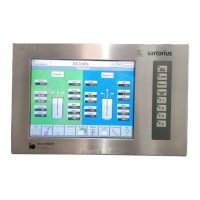Operators Handbook DCU3 – System
6., Main function „Control Loops“
BAEDCU3 - Rev. 4.6 - 0504 6 - 6
6.4.4 PID-Parameter
The PID - controllers can be optimized via the PID - parameters Xp, TI and TD in the corresponding
entries of the menu. The implemented digital controllers allow changes of the control behavior (P, PI,
PD, PID) and of the parameters during operation, which simplifies the optimization of the controllers.
Xp: Proportional range in [%] of measurement range (P-section)
TI: Reset time in seconds (I-section)
TD: Rate time in seconds (D-section)
The control structure can be adjusted by setting the individual PID - parameters to zero :
– P-controller -> TI = 0, TD = 0
– PI-controller -> TD = 0
– PD-controller -> TI = 0
– PID-controller -> alle PID-Parameter defined.
6.4.5 PID Controller Optimization
An optimum adaptation of a PID - controller to its control loop requires detailed knowledge in control
theory. You may refer to any standard literature for proven adjustment rules (e.g. Ziegler Nichols).
Thus the following details are only general guidlines:
The D section (TD) should only be activated in the case of quite stable actual values. Oth-
erwise, if the actual values are varying stochastically the controller output will change con-
siderably and fast. This will lead to an unstable control behavior.
As a general rule the TI : TD ratio should be 4 : 1.
In the case of a periodic oscillating control loop the following measures are recommended:
– increase Xp
– increase TI/TD
If the readjustment is too slow after setpoint jumps or if the actual value drifts, the following
measures are recommended:
– decrease Xp
– decrease TI/TD

